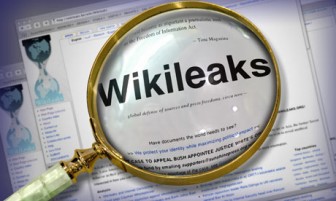Suriname was genuinely shocked that Guyana referred their maritime dispute to the International Tribunal of the United Nations Convention on the Law of the Sea (UNCLOS) and had always tried to ensure that in efforts to resolve the issue the three segments of the boundary – land, river and sea – were not disaggregated but were treated as one in order to get leverage for a settlement, a cable released by WikiLeaks has revealed.
In a comment at the end of a cable sent from the US Embassy in Paramaribo, Suriname to Washington on March 4, 2004, Robert Faucher referred to the New River Triangle/Tigri as being “ultra sensitive” from Suri-name’s point of view, and that Paramaribo had always sought to “bundle” the maritime, riverine and land components of the boundary together in order to “leverage closure.“
He went on to tell Wash-ington that Suriname believed that the blocks to progress were “a) the Guyanese refusal to resolve all three aspects of the dispute at the same time and b) the Guyanese military presence in the disputed land border region.” Once Guyana had resolved the maritime dispute via UNCLOS and focused on the offshore oilfields, Suriname was of the view that Georgetown would have no incentive to resolve the remaining border issues, in particular the New River Triangle/Tigri, he said.
 Guyana had referred the maritime dispute with its eastern neighbour to UNCLOS in 2004, nearly four years after Surinamese gunboats had evicted a CGX oil rig from waters off Coren-tyne, which this country believed fell within its territory. The Award, handed down in 2007, confirmed that the waters in which the rig had sought to operate did in fact belong to Guyana.
Guyana had referred the maritime dispute with its eastern neighbour to UNCLOS in 2004, nearly four years after Surinamese gunboats had evicted a CGX oil rig from waters off Coren-tyne, which this country believed fell within its territory. The Award, handed down in 2007, confirmed that the waters in which the rig had sought to operate did in fact belong to Guyana.
Faucher said that following a visit to China with President Venetiaan, Suri-name Foreign Minister Marie Levens had announced that her country would hire international advisors, many of whom had already contacted the government offering their services to assist with the case. She had also indicated that they would make use of a previously scheduled seminar on Exclusive Economic Zones (EEZ) to discuss Guy-ana’s complaint to UNCLOS with the UN experts attending, and would recall ambassadors and other experts who had worked on the border issue for a meeting to discuss strategy and tactics.
Levens was reported in the cable as declaring that in the light of the case before UNCLOS, Guyana should vacate the New River Triangle/Tigri, and that this move should be taken before discussions could continue on the UNCLOS issue. She said that Guyana had agreed to remove its troops from the area in the 1973 Treaty of Chaguaramas.
The cable alluded to a press report about Venetiaan denying that President Jagdeo had tried to contact him before referring the maritime issue to UNCLOS, while going on to say that Levens had been reported as expressing herself “surprised and disappointed that Guyana had chosen to activate the UNCLOS Dispute Resolution Mechanism, particularly as Guyana and Suriname have had discussions between their Joint Border Commissions in the past two years.” Faucher also recorded Levens’s rejection of President Jagdeo’s claim that “Suriname has obstructed efforts to resolve the border dispute”; Suriname had always been open to dialogue, she said.
Armed Surinamese patrol boats evicted the CGX rig on June 3, 2000, following which negotiations were held under the auspices of Cari-com in Port of Spain, George-town, Paramaribo, Canouan, and finally, Montego Bay and Kingston with Jamaican Prime Minister P J Patterson acting as facilitator. During those negotiations the PPP government resuscitated an offer made first by President Hoyte, ie, that the two countries should engage in joint exploration of the oil resources in the disputed area pending a settlement of the maritime border issue. Suri-name rejected this proposal.
Subsequently, there were bilateral encounters in the form of Joint Meetings of the National Border Commis-sions, the Joint National Border Sub-Commission and the Joint Technical Commis-sion. These produced no result, and it was reported in Georgetown at the time that Suriname was adhering to the position that the discussions should encompass the whole length of the frontier, including the New River Triangle, while Guyana was seeking a resolution of the issue relating to the maritime boundary. It emerged from statements made in the Suriname Parlia-ment last year that Guyana’s eastern neighbour had planned to invade the New River Triangle in 2000.
There has never been any formal agreement or treaty relating to the demilitarization of the New River Triangle, although following incursions by Suriname into the area in 1967 and again in 1969, then Prime Minister Forbes Burnham and Suri-name Premier Jules Sedney issued a joint statement in 1970 committing themselves to the demilitarization of the zone.
Following the failure of the bilateral talks on the maritime dispute, Guyana filed a petition to the International Tribunal for the Law of the Sea on February 24, 2004. The tribunal which handed down its award on September 17, 2007, found that the expulsion of the CGX rig constituted a threat of the use of force in contravention of UNCLOS, the UN Charter and international law. It fixed the boundary along a 10oN line beginning at a marker on the left bank of the Corentyne River laid down in 1936 and continuing for a distance of three miles; thereafter it applied a principle of equidistance to the 200 mile limit of the EEZ claimed by Guyana and Suriname.
The decision made possible the return of CGX to the area, since Guyana had undisputed title to the waters for which the licence to the oil company had been issued.
Earlier this month Guyana submitted a claim under UNCLOs to an extended continental shelf, indicating this was without prejudice to any future delimitation of maritime boundaries with neighbouring states.






